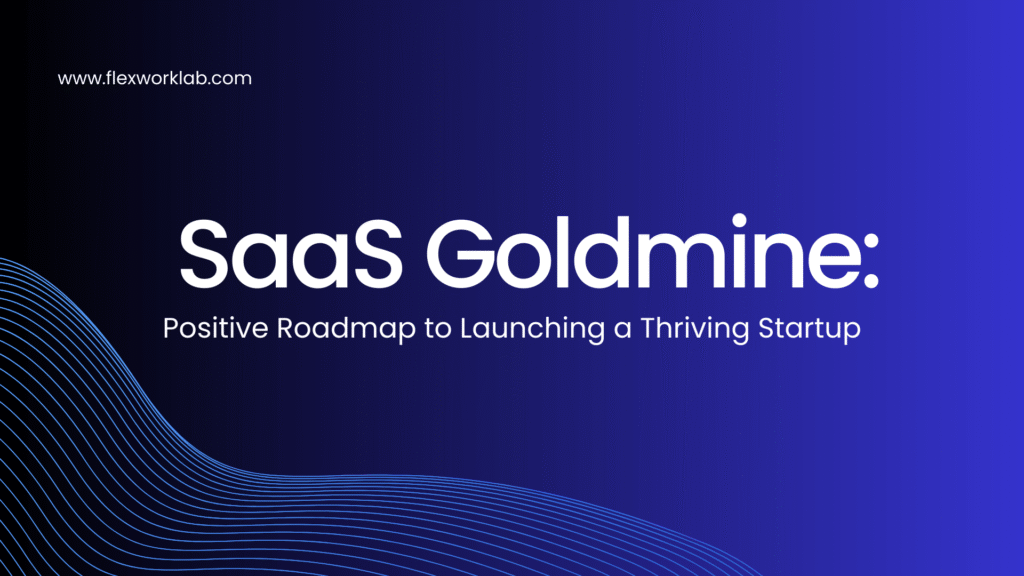
Introduction
Modern business operations are undergoing transformation thanks to Software as a Service (SaaS). Unlike traditional software, SaaS delivery takes place through the internet, and users access it through subscription models. Businesses achieve quicker expansion and establish predictable revenue streams through this model. Today, launching a SaaS business has become more approachable than ever for both solo entrepreneurs and seasoned developers. This guide teaches you to establish a SaaS company from the ground up while showing you how to create SaaS products and develop customer-approved solutions.
1. What is a SaaS Company?
SaaS companies provide cloud-based software accessible through web browsers and mobile apps on demand. Users can access software directly without having to download or install anything. Customers who subscribe receive automatic updates and remote access along with centralized data storage benefits.

The services provided by Slack, Canva, and Shopify operate as SaaS platforms. They serve different needs but share one core attribute: Their solutions to real-world issues work instantaneously by using cloud-based systems. The monthly or yearly billing cycles utilized by SaaS applications lead to more predictable revenue streams for founders.
SaaS companies benefit from quick deployment capabilities and scalable infrastructure. SaaS companies can push new updates to all users at once while gathering real-time feedback and expanding infrastructure resources as user demand grows. The business model generates ongoing revenue by capitalizing on renewals and product expansion while promoting upselling opportunities.
2. Why Start a SaaS Company?
The launch of a SaaS company provides access to both scalable revenue streams and worldwide market presence. Traditional software industries present higher barriers to entry than SaaS businesses. A single founder or small team can transform a market through the right idea and execution plan, along with dedication.
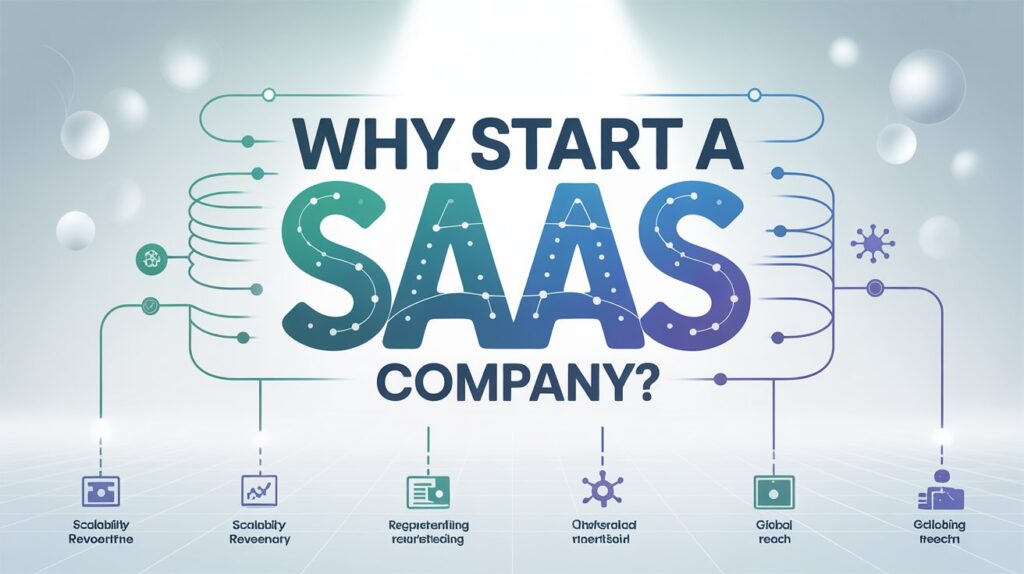
SaaS model companies attract attention through their capability of delivering 24/7 service with reduced operating expenses. The recurring revenue model provides long-term stability. Testing your product with a limited audience lets you modify the product through their feedback before reaching sustainable growth.
Statistical Insight: Statista projects that the global SaaS market will expand from $157 billion in 2020 to $232 billion by 2024. Continuous expansion demonstrates how SaaS companies maintain strength while scaling their operations.
High gross margins that regularly surpass 70% provide a strong motivator for starting a SaaS business because they allow reinvestment into marketing, as well as development and customer support initiatives.
3. How to Start a SaaS Company: The Ultimate Beginner’s Guide to Success
You don’t need to reinvent the wheel. Your business startup should start with solving a unique problem for a specific group of people. That’s where your journey begins. The success of a SaaS business depends on the critical importance of each phase, including idea validation and development through to launch.

The process encompasses market research for needs analysis and user interface design creation, followed by tech stack selection and the formulation of pricing and marketing strategies. Clear execution holds more significance than having big ideas.
3.1 Identify a Pain Point in a Niche Market
A clearly defined problem serves as the foundation of every successful SaaS company. You need to understand your audience deeply: You need to understand which aspects frustrate them and what tasks they spend time on, while also discovering the tools they use.
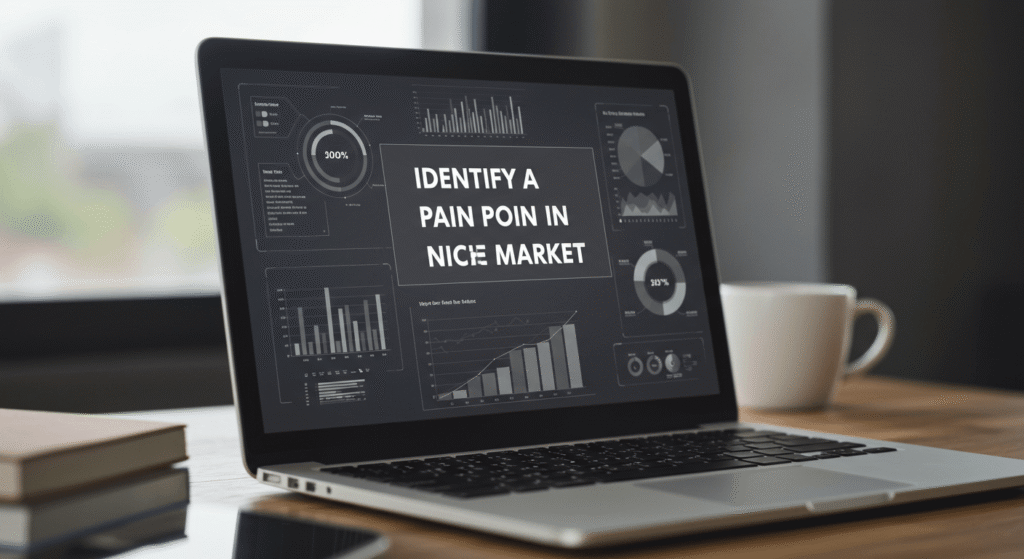
Start by observing industries you’re familiar with. Which repetitive tasks could software automation handle? An inefficiency, together with a communication gap, negatively impacts productivity. By targeting a specific niche, you will make your product more distinctive and enable stronger connections with users.
Examine current competition and evaluate reviews of analogous tools. Identify market openings by locating areas where users face dissatisfaction or inadequate service. Search for user issues, including insufficient features and usability problems, along with complaints about pricing. These elements indicate a potential opportunity within the market.
3.2 Validate Your SaaS Idea Before Building
Don’t assume your idea is valuable—prove it. Validation proves that your solution has people ready to pay for it. The most effective approach to validation is discovering your idea’s worth before spending too much time and money.
Develop a simple landing page to showcase your concept. Promote your product through advertising and social media channels while monitoring the number of update sign-ups. Conduct one-on-one interviews. Run surveys. Share mockups and see how people react. Every response is data.

Case Study: Nathan Barry tested his ConvertKit concept by speaking with bloggers and gathering pre-orders before officially releasing the product. The feedback loop provided product-market fit confirmation before any code was written.
Selling your SaaS product in advance or providing early adopters with discounts serves as a method to gather funds for the initial development stages. Establishing a waitlist or email community generates initial interest for your product before its official release.
3.3 How to Make SaaS: A Powerful Blueprint for Building Scalable Software
Understanding that there’s demand allows you to start building your software. You have two options when starting software development: you can utilize no-code platforms or you can write custom code. Bubble and similar no-code platforms stand out as excellent choices for creating MVPs when you lack technical expertise. Make sure to employ skilled developers when you opt for custom software development.

Use these tools and methods:
- Bubble or Glide for quick MVPs
- JavaScript (React, Vue) for front-end
- Node.js or Python for backend logic
- Select Firebase, AWS, or Supabase to manage both your hosting needs and database services.
Prioritize developing only the essential features required to address the primary issue. Avoid spending time on developing extra features that serve no purpose.
Design intuitive user interfaces that simplify onboarding. Design your SaaS using prototyping tools such as Figma before beginning the coding process. Establish precise feature milestones and launch your product when the core experience becomes operational.
3.4 Develop SaaS Like a Pro: Essential Strategies for Smart Founders
Good planning and smart practices are essential components of effective SaaS development. Visualize user interactions with your product by beginning with wireframes and flowcharts. Implement short development sprints to enable frequent feature testing.

You’ll also need robust backend architecture. Consider data protection measures along with authentication protocols and system efficiency. Weekly standups and retrospectives should be scheduled when you follow Agile practices to maintain team alignment. Don’t skip documentation—future you will thank you.
Remember, software development is never really “done.” It evolves. Closely listening to your users will direct the direction of your software updates.
Efficient software deployment requires version control through Git along with automated testing and continuous maintenance of CI/CD pipelines. Design your product to handle large-scale usage right from the beginning, although you may start with a minimal user base.
3.5 Build a SaaS from Scratch: The Definitive Guide for First-Time Founders
From a technical and business standpoint, building a SaaS from scratch means setting up everything: infrastructure, analytics, security, and user management.
Start with a reliable hosting solution. Use GitHub for version control. Implement your application with hosting services such as Vercel or Heroku and establish CI/CD mechanisms to streamline update processes. Mixpanel and Google Analytics serve as critical utilities for tracking user behavior.
Security Table:
| Security Feature | Importance Level | Tools/Services |
| Data Encryption | High | SSL, HTTPS, Let’s Encrypt |
| Authentication | High | Auth0, Firebase Auth |
| GDPR Compliance | Medium | Termly, iubenda |
| Daily Backups | High | AWS S3, Backblaze |
Your app must support mobile responsiveness and function on multiple devices. Ensure your app loads quickly and provides seamless user experiences.
3.6 Price and Monetize Your SaaS Product
Your product’s pricing strategy extends beyond mere numbers because it plays a crucial role in positioning your product in the market. A proper pricing strategy creates perceived value, leading to customer acquisition and business expansion. Analyze your ideal users’ payment willingness by examining the problem your solution solves and its delivered value.
Consider these three proven models:
- Freemium: Start by giving users access to a basic plan at no cost and then sell them more advanced features.
- Tiered pricing: Develop a range of pricing plans that offer expanded features or higher usage limits to cater to various customer segments.
- Usage-based: Apply usage-based billing methods such as per-user charges or transaction fees, as well as storage costs measured in GB.
Apply psychological pricing, which shows $9.99 prices instead of whole numbers like $10 to boost conversion rates. Implement several pricing tactics and promotional offers, such as early-bird discounts and lifetime licenses, to attract your starting user base. Monitor churn rates and ARPU along with CAC to help you make pricing decisions throughout your business development.
Introduce discounted annual plans to enhance both cash flow stability and customer retention.
3.7 What are the initial expenses for launching a SaaS business? Real Numbers and Smart Tips
The capital needed to start a SaaS business varies significantly based on multiple factors. Creating a basic MVP requires an investment of about $5,000, but a full product developed by a developer team will demand over $100,000. The initial startup costs for your SaaS business are determined by your technical skills and the product features you intend to build, and whether you decide to employ outside developers or use your internal team.
Estimated SaaS Startup Budget:
| Category | Estimated Cost Range |
| MVP Development | $5,000 – $20,000 |
| Hosting & Tools | $500 – $2,000/year |
| Marketing Budget | $1,000 – $10,000 |
| Legal & Compliance | $500 – $3,000 |
Plan your budget around the MVP first. The ability to scale your business becomes available when you start generating revenue.
Cost reduction can be achieved through the use of open-source solutions and no-code tools, alongside hiring development talent from regions with lower wages.
4. Launch and Market Your SaaS Product
A carefully planned product launch enables rapid user acquisition. Start with a small beta group. These users will deliver critical feedback together with testimonials. Their feedback helps you address software defects and improve your product communication.
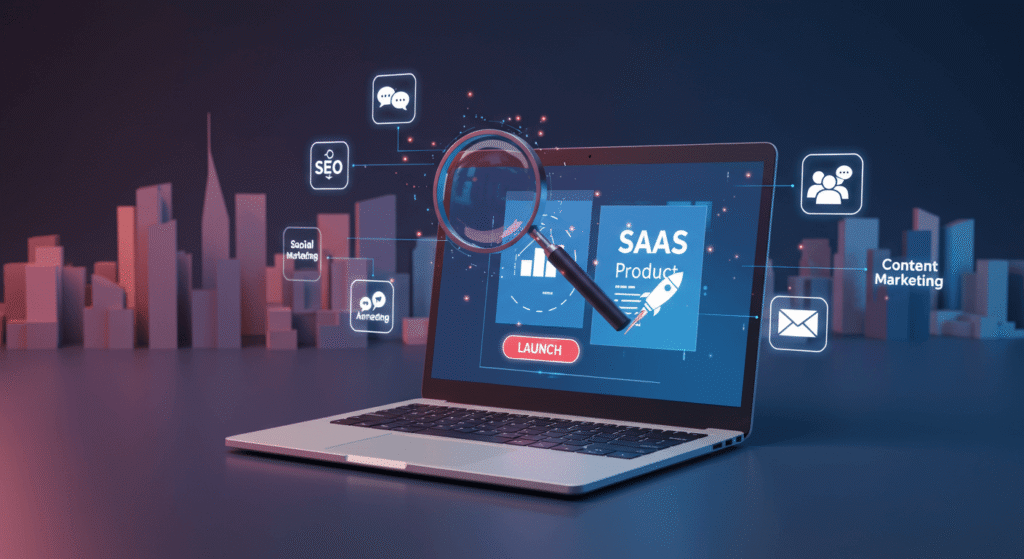
Promote your launch through platforms such as Product Hunt and Indie Hackers alongside social media channels. Initiate the development of your mailing list well before your product launch to generate anticipation. Content marketing provides an economical way to establish your brand’s credibility.
Discover effective marketing strategies to employ during your pre-launch and launch phases:
- Tease your product to your audience through targeted email messages and Twitter posts.
- Offer exclusive discounts to early adopters.
- Send your product details to startup directories along with SaaS review websites.
Track every campaign. Study your conversion rates and modify your strategy based on your findings. Marketing requires continuous effort because it never ends after an initial launch.
5. Post-Launch: Retention, Scaling & Customer Support
Once your product goes live, it’s time to concentrate on customer retention while setting up for future growth. Personalized onboarding alongside email sequences and helpful tutorials helps keep users engaged. Collect feedback consistently to help refine your product roadmap.
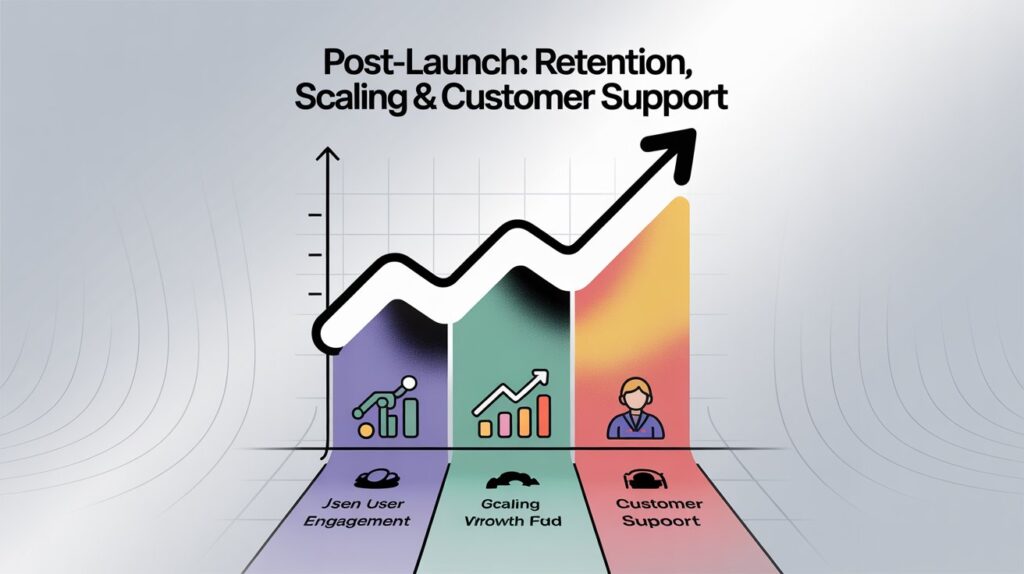
Customer support needs to provide quick responses combined with friendly interactions and expert knowledge. Small SaaS teams are capable of delivering excellent service by utilizing appropriate tools. Implement chatbots and helpdesk tools as solutions to make your ticket management system more efficient.
Measure user satisfaction by examining metrics like Net Promoter Score (NPS), churn rate, and average session duration.
To scale your business reach, review affiliate programs while developing partnerships and exploring international markets. Ensure your infrastructure remains stable and performs optimally even as traffic grows.
6. Common Mistakes to Avoid When Starting a SaaS Business
Many first-time founders make avoidable mistakes. Developing products without validation stands out as one of the most significant errors. Many developers focus excessively on refining their product, which leads to missing out on valuable real user feedback.
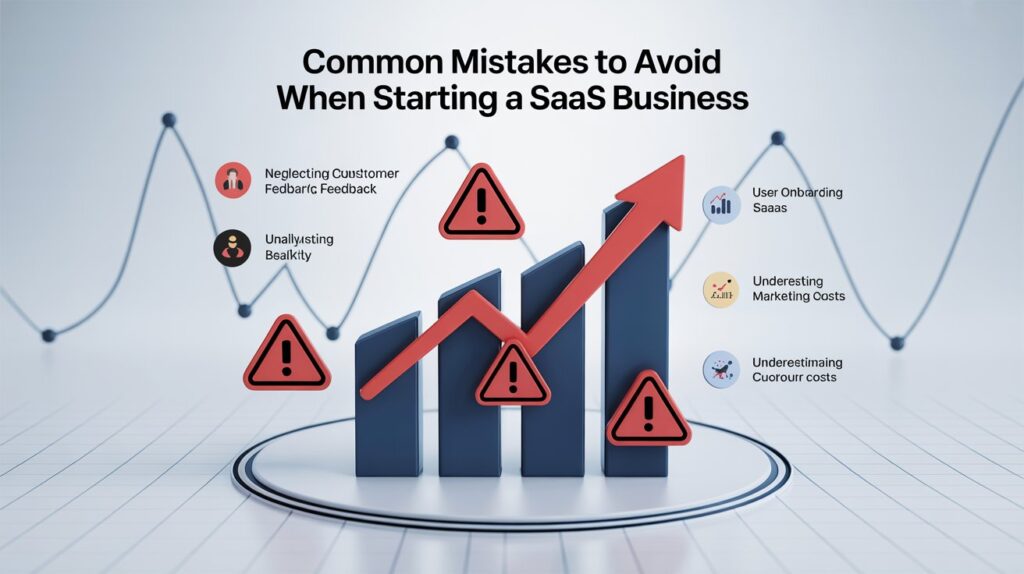
A great product will not sell itself, so marketing must be actively managed. When you charge too little for your product, it can prevent serious buyers from approaching your business.
Do not create a complicated product with universal appeal because it will not meet specific user needs. Concentrate on resolving a single primary issue before moving on to develop further features.
When important SaaS KPIs such as MRR (Monthly Recurring Revenue) and churn remain untracked, your business operates without essential data.
7. Final Thoughts: Your Roadmap to SaaS Success
Breaking down the process into steps makes starting a SaaS company manageable despite its overwhelming nature. Each phase, from problem identification through product development to launch, provides learning and growth opportunities.

You need to combine persistence with user empathy and iterative development to succeed with SaaS products. You can reach long-term success when you begin with small initiatives and validate your concept by listening to user feedback. The difficulties you encounter along this way will ultimately prove worthwhile because your results will validate your efforts.
Continuously improve your product and strengthen user connections while reinvesting resources into successful elements. Your SaaS journey is just beginning.
FAQs
What steps should I follow to start my SaaS business?
To start your SaaS business you need to discover a real-world issue then confirm your solution works with prospective users prior to building a minimal viable product.
What is the average development time needed to create a functional SaaS product?
Three to six months is required to develop an MVP based on product complexity.
Can entrepreneurs establish a SaaS business without programming expertise?
To bring your vision to life, you have two options: use no-code tools or hire developers.
Which funds are What funds do you need to start a SaaS business venture?
Your initial budget for starting a SaaS business should range from $5,000 to $15,000, which will cover development expenses and initial hosting, along with marketing costs.

